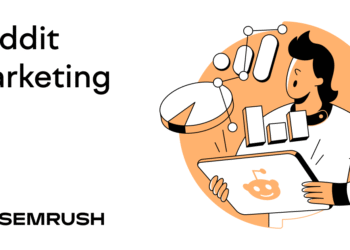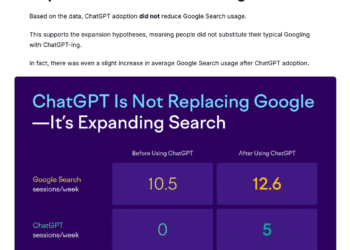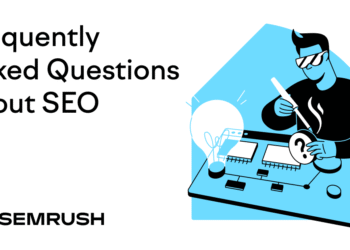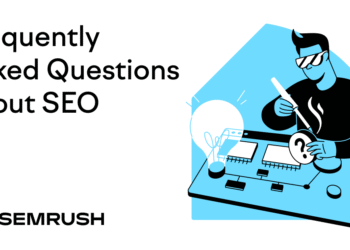There was a time when the information superhighway of the internet was full of links and pages but there was a pressing question for marketers navigating what kinds of information to create: what is content?
That was a question I posed when preparing for a presentation on the future of content for an audience of interactive marketers in Minneapolis. I wanted a baseline for describing the future of content by understanding how an audience of marketers in my network defined content in the first place.
The result was a poll shared across my social networks resulting in 40+ answers from a wide range of marketing experts. There were a variety of responses from the literal to the creative and ultimately it was an interesting exercise.
What is content?
A basic definition of content is that it is a collection of ideas transformed into a format consumable by others such as text, image, audio, video or interactive.
However, when reviewing the answers from the poll I ran, I noticed that several patterns emerged, clustering the content definitions into 3 groups:
- Practical and informational
- Experiential and use-based
- Too ambiguous to define
It has been said that we now produce more content on daily basis than any individual could consume in a lifetime. And today, the advent of AI-generated content and the incentives to create and repurpose content by marketers along with the democratization of content creation which includes UGC (user generated content), EGC (employee generated content), IGC (influencer generated content) / CGC (creator generated content) is simply overwhelming.
When I originally ran this poll to simply define content I don’t think I (or anyone answering the poll) could have imagined the range of ways that content could be understood. Thinking about this understanding of content brought me to the idea of all the ways modern content can be categorized.
What are the categories of content for marketing?
Here are 8 examples of how content could be categorized for use in B2B marketing.
1. Content by Purpose
Primary goal or the core job it is meant to do for the business.
- Thought Leadership (e.g., opinion pieces, trend forecasts, industry predictions)
- Educational (e.g., how-to guides, tutorials, best practice explainers)
- Promotional (e.g., product launch announcements, feature updates, sales collateral)
- News & Announcements (e.g., press releases, company milestones, hiring updates)
- Case Studies / Success Stories (e.g., customer testimonials, proof of ROI)
- Research & Reports (e.g., original industry surveys, data analysis, white papers)
- Community-Building (e.g., user-generated content showcases, expert Q&As)
- Entertaining (e.g., humorous posts, behind-the-scenes looks, company culture spotlights)
2. Content by Format
Medium or structure used to deliver the content.
- Written
- Blog posts & Articles
- eBooks & White papers
- Newsletters & One-pagers
- Website copy
- Visual
- Infographics
- Charts & Diagrams
- Slide decks / Presentations
- Memes & GIFs
- Video
- Webinars (live or recorded)
- Product demos & Explainers
- Interviews & Panel discussions
- Short-form video (Reels, Shorts, etc.)
- Audio
- Podcasts
- Audiograms (static images with audio overlays for social media)
- Interactive
- Quizzes & Assessments
- Calculators (e.g., ROI calculators)
- Interactive reports & Polls
3. Content by Marketing Goal & Funnel Stage
Role in the buyer’s journey, mapping specific marketing objectives to different stages of awareness and consideration.
- Top of Funnel (TOFU) / Brand Awareness: Attracts a broad audience and makes them aware of a problem or need.
- Examples: Blog posts, infographics, social media content, thought leadership articles.
- Middle of Funnel (MOFU) / Lead Generation & Nurturing: Educates potential buyers, builds trust, and captures leads.
- Examples: Webinars, in-depth guides, case studies, white papers, email nurture sequences.
- Bottom of Funnel (BOFU) / Sales Enablement & Conversion: Helps qualified leads make a final purchase decision.
- Examples: Product demos, pricing pages, free trials, implementation guides, comparison sheets.
- Post-Sale / Customer Retention & Advocacy: Supports, delights, and retains existing customers to turn them into advocates.
- Examples: Onboarding tutorials, knowledge base articles, customer-only webinars, success stories.
4. Content by Target Audience
Needs of a specific Ideal Customer Profile (ICP), persona, or stakeholder group.
- Job Role (e.g., content for a CMO vs. content for a Marketing Operations Manager)
- Industry (e.g., tailoring a case study for healthcare vs. fintech)
- Seniority (e.g., strategic content for C-suite decision-makers vs. tactical content for end-users)
- Pain Point or Need (e.g., content addressing how to increase pipeline vs. how to improve customer experience)
5. Content by Distribution Channel
Where content will be published and promoted.
- Owned Media (e.g., company website, blog, email newsletter)
- Shared Media (Social) (e.g., LinkedIn, YouTube, X, Facebook)
- Earned Media (e.g., PR placements, guest posts on other sites, organic mentions)
- Paid Media (e.g., search ads, social media ads, sponsored content)
- Influencer / Partner Channels (e.g., content co-created with or promoted by industry partners)
6. Content by Timeliness & Lifecycle
Temporal relevance and intended lifespan.
- Evergreen: Content that remains relevant for a long time with minimal updates.
- Seasonal / Timely: Content tied to a specific holiday, season, or time-sensitive event.
- Campaign-Specific: Content created for a single, time-bound marketing campaign.
- Real-time / Reactive: Content created quickly in response to a current event or trend.
- Archived / Outdated: Content that is no longer relevant and may be removed or updated.
7. Content by Personalization Method
Methods used to dynamically organize and present it to individual users. It differs from the funnel stage category in that it focuses on the automated delivery of content, not just its strategic creation.
- User Behavior & History (The “What You’ve Done” Model)
- Collaborative Filtering (The “People Like You” Model)
- Explicit User Preferences (The “What You’ve Told Us” Model)
- Context & Environment (The “Where You Are Now” Model)
- User Attributes & Demographics (The “Who You Are” Model)
- User Journey Stage (The “Where You Are in Your Relationship” Model)
8. Content by Creation Method
Authorship source with an emphasis on AI or Human or…
- Human-Crafted: Created entirely by human writers, designers, or strategists.
- AI-Assisted: Human-led creation that uses AI tools for research, outlining, or editing.
- Hybrid: Collaborative creation where human and AI contributions are deeply intertwined.
- AI-Generated, Human-Edited: Generated by an AI model and then reviewed, fact-checked, and refined by a human.
- Pure AI-Generated: Published directly from an AI model with little to no human editing.
When you consider the breadth and depth of content options today, the taxonomy of content categorization can get pretty robust – far more detailed than most marketers would use practically. However, I think it is useful to understand the scope of consideration that can be involved when creating a content strategy for your business. As I’ve said in the past as a rebut to Bill Gates’ famous quote,
“Content isn’t King. It’s the Kingdom”
For reference, below are the 40+ original responses I received from the poll about defining content that are segmented by the categories in which they fit:
Content is Information (practical, functional, tactical)
@ MeetTheBossTV – Content is: engaging, relevant, reliable, interesting, entertaining or enlightening in the form of text, image, video or audio.
Heidi Cohen G+ – Content is high quality, useful information that conveys a story presented in a contextually relevant manner with the goal of soliciting an emotion or engagement. Delivered live or asynchronously content can be expressed using a variety of formats including text, images, video, audio and/or presentations. When used for marketing purposes, content should incorporate the organization’s branding, be void of any form of promotion, and use a call-to-action to be trackable.
Scott Hepburn G+ – Information designed for consumption, seasoned for enjoyment, and packaged to share.
Bryan Eisenberg (Facebook) – Think of Web content as the public conversation that happens between you and the visitor, whether the conversation is one-way (from you to the visitor), two-way (between the visitor and you), or conversation among visitors.
@ derekhalpern – Content comes in any form (audio, text, video), and it informs, entertains, enlightens, or teaches people who consume it.
Courtney Ramirez G+ – It’s the stuff you publish – which covers writing, visuals, video, presentations – etc. It can be published on blogs, webpages, social accounts, etc.
@ dogwalkblog – words, photos, video, sound
Kevin Cain G+ – Content is a compilation of information, ideas, and messages that are translated into some kind of written, visual, or audible format for others to consume.
David Erickson (Facebook) – Relevant, compelling, timely and valued knowledge and/or entertainment.
Evyenia Wilkins G+ – Content is anything you produce that your audience can consume with its senses.
@ bigboxcar – Content is anything produced & published either sporadically or planned. And this content can be used to then create more content.
Sarah Webster Worsham (Facebook) – Content is something that provides information to the viewer/reader/etc. Good content provides value.
@ MjGlobalCom – foto, video, blog, infographic, interview, article, montage, editorial, review, mashup, meme, story, song, how-to, lists, tips
@ contenttribe – Information that is useful, has a context, easy to consume, device agnostic, shareable and non intrusive.
Todd Greene G+ – Simple: Information. Good, or bad
@ _nicoleespears – Original and opinion-charged copy with a focused message and personalized voice.
@ scotcarlson – Information –designed for consumption & further distribution across the web (ideally includes multimedia and sharing elements).
Charlene Burke G+ – Content fills a space. The space defines the type of content.
@ derekedmond – any medium designed to execute a message. Could be text, video, image, audio, etc
@ lifewithlevi – Quality words that make sense. Whether humorous, informational, or advertorial, content needs to be relevant AND engaging.
@ brettasnyder – Content is any form of authentic communication b/t a business owner & audience that serves to solve a problem/help the audience
@ JLBraaten – I’d define content as information presented on the web
Content is Experience (Useful, Purposeful, Outcome Oriented)
Avinash Kaushik G+ – Content is anything that adds value to the reader’s life. It can add value by making them smarter, making them laugh, making them do their job better, rush to their child to share the video, make a contribution to a charity.
Vincent Green G+ – I am content on a warm summer’s night with a roaring fire in the pit and some cool beer. Some scotch & cigars to close. Content in the fact that my content is generating. Mmmmmmmmm
Mike Grehan (Facebook) – I wish we’d stop talking about content – manure is content and so is cold porridge… not many people want to consume it though! How about creating an “experience” as opposed to content?
Kathryn Aragon G+ – Content is any information that builds trust and authority among your ideal customers.
@ jillvan – Think of your brand as having legs. The left leg, content, makes people care. The right leg is delivering on your brand promise.
Joan Damico G+ – Content is any communication in any medium that serves a purpose, whether it be to influence, educate, inform, warn, express one’s self or spark conversation within a given context.
Joe Pulizzi G+ – Compelling information that informs, engages or amuses.
Chris Baggott (Facebook) – An element that engages a person
Lyndon NA G+ – Anything on a URL that can be used (be it read, looked at, downloaded or interacted with).
Brian Massey G+ – My definition of content is “information with a purpose for a targeted audience.” Information may be text, video, audio, photos, etc. Purpose might be to educate, entertain, or persuade (convert).
@ connell_vs_life – Relevant information – whether it be written or auditory or visual that someone wants to digest, and dissect and experience.
Dan Bischoff G+ – Such a broad question. Could be spam, could be some technical writing on the back of a product, could be ad copy, etc. In marketing, what it should be is: anything that creates brand advocacy, leads potential customers down the conversion path, or nurtures leads and current customers.
@ brianhalligan – Content: units of visual or auditory info that drive reactions by telling stories, asking questions, or supporting conclusions
Kevin Dugan G+ – Content is broadly defined because it’s changing. I think the definition is the issue and the opportunity. It’s also defined differently based on your background. Content is the monkey in the middle of the audience and the outcome. Yeah, Zen, right?
Barry Feldman G+ – I’ll simply say: the answers to customers’ questions
Andrew Johnson G+ – Content is anything created to be engaging, clever, insightful, beautiful and intelligent, and should fundamentally connect with your target audience.
“Content” is Too Ambiguous to Define
Matthew T. Grant G+ – Lee – your question, and many of the answers, highlights what is problematic about the term “content”. If one can reasonably begin a response with “Content is anything…” then content isn’t anything in particular. “Content,” in the end, is the generic binary term to “form,” where form could be a physical form—a box, a jar, a bottle—or a conventional form of media—a video, a show, an essay, a blog post, a play, a novel. Thus, I like the definitions above that basically say “content=information,” in the sense that content is the stuff that goes in various forms.
Olivier Blanchard (Facebook) – The thing about the term “content” is that it’s just vague enough to mean everything and anything, which is to say it doesn’t mean anything at all. It’s essentially a word that means “stuff to fill an empty space with.” It could be photos, video, marketing copy, thorough analysis, poetry, farts, vacuous nonsense, cat hair or cheese cubes. The only thing it hints at is that there is a finite volume of the space it must fill. Ironically, the word itself is a vessel for more content: Here’s an empty word. Now fill it with meaning.
Tom Webster (Facebook) – I’ve always hated the term, to be honest. It reminds me of the eternal cereal box disclaimer: contents may settle due to handling.
How to define content today
From a 2025 perspective, the historical debate over defining content, whether as functional information, a purposeful experience, or an ambiguous filler term, has evolved into a new strategic imperative for B2B companies. While content remains rooted in information, the rise of generative AI has commoditized its production, shifting the primary differentiator to the quality of the customer experience it delivers. In the future will it matter as much how the content was created compared to the value it creates for customers and the business?
This AI-friendly view of content seems to validate the critique that “content” can be meaningless, which may force marketers to choose between creating low-value “digital landfill” and creating high-impact assets that create authentic value, build trust and drive business outcomes.
Looking ahead towards to the future of content, I think the definition is transforming again. I think that for business related information, we might be moving beyond individual assets like videos or research reports or podcasts toward the creation of intelligent content systems.
Orchestrated by humans but implemented by AI, these would be dynamic, interconnected ecosystems of information that can adapt to user context and power the entire customer journey dynamically. Maybe that sounds like science fiction, but I do wonder if that’s the direction content for business marketing is going in the future.
Having said that, I think as AI scales, for certain segments of the business population, the hunger for human originated information in familiar formats will continue to play a role. Maybe a more important role than it does now.
How Can a Human Inspired, AI Optimized Content Marketing Strategy Grow Your Business?
















![Clicks Don’t Pay the Bills: Use This Audit Framework To Prove Content Revenue [Mozcon 2025 Speaker Series]](https://mgrowtech.com/wp-content/uploads/2025/05/MozCon-25-Speaker-Profile-Cards-2-120x86.png)

